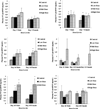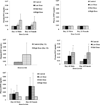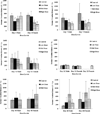2-Deoxy-d-Glucose (2-DG)-Induced Cardiac Toxicity in Rat: NT-proBNP and BNP as Potential Early Cardiac Safety Biomarkers
- PMID: 26838190
- PMCID: PMC4864115
- DOI: 10.1177/1091581815624397
2-Deoxy-d-Glucose (2-DG)-Induced Cardiac Toxicity in Rat: NT-proBNP and BNP as Potential Early Cardiac Safety Biomarkers
Abstract
2-Deoxy-d-glucose (2-DG) is being developed as a potential anticonvulsant and disease-modifying agent for patients with epilepsy; however, during preclinical development, cardiac toxicity has been encountered in rats. This study was performed to determine whether cardiac troponin (cTnI and cTnT), atrial natriuretic peptide (ANP), brain natriuretic peptide (BNP), N-terminal pro-brain natriuretic peptide (NT-proBNP), and/or creatine kinase (CK) could be useful as indicators of 2-DG cardiac toxicity. In addition, this study also investigated the association of cardiac histopathological changes with these biomarkers. F344 rats (4/sex/group/sacrifice point) were gavaged with either vehicle or 2-DG (50, 125, or 375 mg/kg twice daily; total daily dose of 100, 250, or 750 mg/kg/d) for 7, 14, 21, or 45 days followed by a 15-day recovery. Dose-dependent increases in NT-proBNP and BNP plasma concentrations were observed. Following recovery period, the NT-proBNP and BNP concentrations returned to baseline levels. There were no remarkable increases in CK, ANP, cTnI, or cTnT concentrations. There were no gross cardiac lesions observed at the necropsy. Microscopic findings of vacuolar degeneration and hypertrophy of the endothelial cells of the endocardium were present in the heart at doses of 250 and 750 mg/kg/d. Microscopic findings, in general, were associated with increases in NT-proBNP levels. Cardiac toxicity appeared to be reversible. In conclusion, NT-proBNP and BNP are potential early biomarkers for 2-DG-induced cardiac toxicity that can be useful to monitor 2-DG therapy in clinical trials.
Keywords: 2-deoxy-d-glucose; BNP; NT-proBNP; vacuolar degeneration.
© The Author(s) 2016.
Conflict of interest statement
The author(s) declared the following potential conflicts of interest with respect to the research, authorship, and/or publication of this article: TPS holds a use patent for 2-DG.
Figures




References
-
- Vamecq J, Vallée L, Lesage F, Gressens P, Stables JP. Antiepileptic popular ketogenic diet: emerging twists in an ancient story. Prog Neurobiol. 2005;75:1–28. - PubMed
-
- Huttenlocher PR. Ketonemia and seizures: metabolic and anticonvulsant effects of two ketogenic diets in childhood epilepsy. Pediatr Res. 1976;10:536–540. - PubMed
-
- Hu XL, Cheng X, Fei J, Xiong ZQ. Neuron-restrictive silencer factor is not required for the antiepileptic effect of the ketogenic diet. Epilepsia. 2011;52:1609–1616. - PubMed
-
- Garriga-Canut M, Schoenike B, Qazi R, Bergendahl K, Daley TJ, Pfender RM, Morrison JF, Ockuly J, Stafstrom C, Sutula T, Roopra A. 2-Deoxy-D-glucose reduces epilepsy progression by NRSF-CtBP-dependent metabolic regulation of chromatin structure. Nat Neurosci. 2006;9:1382–1387. - PubMed
Publication types
MeSH terms
Substances
Grants and funding
LinkOut - more resources
Full Text Sources
Other Literature Sources
Research Materials

